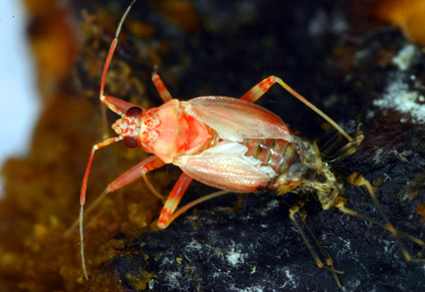Abstract
Three new species of the fungal-inhabiting plant bug genus Punctifulvius Schmitz, 1978 (Cylapinae: Fulviini) are described, namely P. aleksanderi n. sp. from Selangor, Malaysia, P. parvus n. sp. from East Kalimantan, Indonesia, and P. sakaerat n. sp. from Nakhon Ratchasima, Thailand. The present discovery represents the first record of the genus from the Oriental Region. Punctifulvius members are now confirmed to be widespread from the cold temperate climatic zones in the eastern Palearctic regions, across the tropics of the Oriental Region, to the temperate rainforest of Australia. Punctifulvius kerzhneri Schmitz, 1978 is recorded from Taiwan for the first time. The systematic position of Teratofulvioides Carvalho & Lorenzato, 1978 is discussed, and its single species Teratofulvioides punctatus Carvalho & Lorenzato, 1978 is redescribed. Color adult habitus images of Punctifulvius aleksanderi, P. kerzhneri, P. parvus, P. sakaerat, and Teratofulvius punctatus, images of male (P. parvus and P. sakaerat) and female (P. aleksanderi) genitalic structures, as well as scanning electron micrographs of selected structures of P. aleksanderi, P. kerzhneri, P. parvus, P. sakaerat, and T. punctatus are provided. Key to the species of Punctifulvius is given.
References
- Aukema, B. (2018) Catalogue of the Palaearctic Heteroptera (searchable database). Available from: https://catpalhet.linnaeus.naturalis.nl/ (accessed 23 October 2023)
- Bergroth, E. (1910) Über die Gattung Bothriomiris Kirk. Wiener Entomologische Zeitung, 29, 235–238. https://doi.org/10.5962/bhl.part.23356
- Carvalho, J.C.M. & Lorenzato, L.M. (1978) The Cylapinae of Papua New Guinea (Hemiptera, Miridae). Revista Brasileira de Biologia, 38, 121–149.
- Cassis, G. (2008) The Lattinova complex of Austromirine Plant Bugs (Hemiptera: Heteroptera: Miridae: Orthotylinae). Proceedings of the Entomological Society of Washington, 110, 845–939. https://doi.org/10.4289/0013-8797-110.4.845
- Conrad, O., Bechtel, B., Bock, M., Dietrich, H., Fischer, E., Gerlitz, L., Wehberg, J., Wichmann, V. & Böhner, J. (2015) System for Automated Geoscientific Analyses (SAGA) version 7.3.0. Geoscientific Model Development, 8 (7), 1991–2007. https://doi.org/10.5194/gmd-8-1991-2015
- Davis, N.T. (1955) Morphology of the female organs of reproduction in the Miridae (Hemiptera). Annals of the Entomological Society of America, 48 (3), 132–150. https://doi.org/10.1093/aesa/48.3.132
- Gorczyca, J. (2006) The catalogue of the subfamily Cylapinae Kirkaldy, 1903 of the world (Hemiptera, Heteroptera, Miridae). Monographs of the Upper Silesian Museum, 5, 1–100.
- Kerzhner, I.M. (1988) Sem. Miridae (Capsidae) – Slepnjaki. Opredelitel’ Nasekomykh Dal’nego Vostoka SSSR [Keys to the insects of the Soviet Far East] 2. Nauka, Leningrad, pp. 778–857. [in Russian]
- Kerzhner, I.M. & Josifov, M. (1999) Miridae Hahn, 1833. In: Aukema, B. & Rieger, C. (Eds.), Catalogue of the Heteroptera of the Palearctic Region, vol. 3, Cimicomorpha II. The Netherlands Entomological Society, Amsterdam, 576 pp.
- Kim, J., Lim, J. & Jung, S. (2019) A taxonomic review of the fungal-inhabiting plant bugs (Hemiptera: Heteroptera: Miridae: Cylapinae) from the Korean Peninsula. Journal of Asia-Pacific Biodiversity, 12, 249–256. https://doi.org/10.1016/j.japb.2019.01.006
- Kirkaldy, G.W. (1903) Einige neue und wenig bekannte Rhynchoten. Einege neue und wenig bekannte Rhynchoten. Wiener entomologische Zeitung, 22, 13–16.
- Konstantinov, F.V. (2003) Male genitalia in Miridae (Heteroptera) and their significance for suprageneric classification of the family. Part 1: general review, Isometopinae and Psallopinae. Belgian Journal of Entomology, 5, 3–6.
- Namyatova, A.A. & Cassis G. (2019) Total-evidence phylogeny of the Rhinomirini, taxonomic review of its subgroupings (Insecta: Heteroptera: Miridae: Cylapinae) and description of new Australian taxa. Zoological Journal of the Linnean Society, 187 (4), 1196–1252. https://doi.org/10.1093/zoolinnean/zlz058
- Namyatova, A.A. & Cassis, G. (2022) Review of Australian Cylapinae (Hemiptera: Heteroptera: Miridae) with key to genera and descriptions of new species. Insect Systematics & Evolution, 8, 1–72. https://doi.org/10.1163/1876312X-bja10032
- Poppius, B. (1909) Zur Kenntnis der Miriden-Unterfamilie Cylapina Reut. Acta Societatis Scientiarum Fennicae, 37 (4), 1–46. https://doi.org/10.5962/bhl.title.9441
- Poppius, B. (1914) Neue orientalische Cylapinen. Wiener Entomologische Zeitung, 33, 124–130. https://doi.org/10.5962/bhl.part.17786
- Poppius, B. (1915) H. Sauter’s Formosa-Ausbeute: Nabidae, Anthocoridae, Termatophylidae, Miridae, Isometopidae und Ceratocombidae (Hemiptera). Archiv fur Naturgeschichte, 80A (8), 1–80.
- SAGA Development Team (2023) System for Automated Geoscientific Analyses (SAGA) version 7.8.2. Institute of Geography at the University of Hamburg, Germany. Available from: http://www.saga-gis.org (accessed 25 September 2023)
- Schmitz, G. (1978) Description de deux nouveaux genres asiatiques de Fulviini Uhler 1886 (Heteroptera Miridae). Bulletin et annales de la Societe entomologique de Belgique, 114, 183–195.
- Schuh, R.T. (1995) Plant bugs of the world (Insecta: Heteroptera: Miridae): Systematic catalog, distributions, host list, and bibliography. New York Entomological Society, i–xii + 1329 pp.
- Schuh, R.T. (2002–2013) On-line Systematic Catalog of Plant Bugs (Insecta: Heteroptera: Miridae). Available from: http://research.amnh.org/pbi/catalog/ (accessed 25 September 2023)
- Schuh, R.T. & Weirauch, C. (2020) True Bugs of the World (Hemiptera: Heteroptera). Classification and Natural History. 2nd Edition. Siri Scientific Press, Manchester, 767 pp.
- Tyts, V.D., Namyatova, A.A. & Konstantinov, F.V. (2022) Phylogeny of the Rhinocylapus complex (Heteroptera, Miridae, Cylapinae, Fulviini). Invertebrate Systematics, 36 (8), 751–779. https://doi.org/10.1071/IS21061
- Uhler, P.R. (1886) Check-list of the Hemiptera Heteroptera of North America. Brooklyn Entomological Society, Brooklyn, New York, iv + 32 pp. https://doi.org/10.5962/bhl.title.12636
- Wolski, A. (2010) Revision of the Rhinocylapus-group (Hemiptera: Heteroptera: Miridae: Cylapinae). Zootaxa, 2653 (1), 1–36. https://doi.org/10.11646/zootaxa.2653.1.1
- Wolski, A. & Gorczyca, J. (2011) Rhinocylapoides brachypterus, a new cylapine genus and species from Malaysia (Hemiptera: Heteroptera: Miridae). Zootaxa, 3040 (1), 19–24. https://doi.org/10.11646/zootaxa.3040.1.2
- Yasunaga, T. (2000) The mirid subfamily Cylapinae (Heteroptera: Miridae), or fungal inhabiting plant bugs in Japan. Tijdschrift voor Entomologie, 143, 183–209. https://doi.org/10.1163/22119434-99900044
- Yasunaga, T. (2001) Family Miridae Hahn, plant bugs. In: Yasunaga, T., Takai, M. & Kawasawa, T. (Eds.), A Field Guide to Japanese Bugs II. Zenkoku Noson Kyoiku Kyokai, Publishing Co. Ltd., Tokyo, pp. 2–96, 112–351. [in Japanese]
- Yasunaga, T. & Miyamoto, S. (2006) Second report on the Japanese cylapine plant bugs (Heteroptera, Miridae, Cylapinae), with description of five new species. Hug the bug—For love of true bugs. Festschrift zum 70. Geburstag von Ernst Heiss. Denisia, 19, 21–735.


